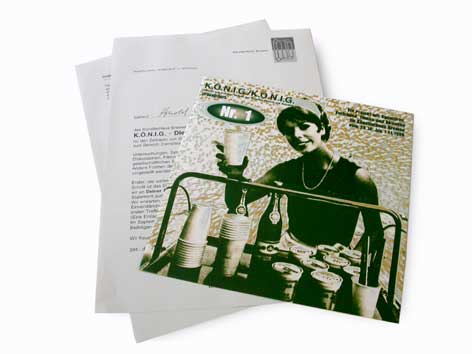K.Ö.N.I.G, Dienst am Kunden

Contribution to the exhibition "K.Ö.N.I.G, Dienst am Kunden" (K.I.N.G. Customer Service), in the KünstlerHaus am Deich, Bremen STATEMENT
Culture is the reservoir of a multitude of visions of individuals (e. g. visual artists) who refuse to accept reality as an objective fact. They offer personal alternatives. Artists are engaged in the business of free connection, free association and synthesis. They collect, examine, analyze and finally propose new arrangements. Artists are mobile. They leave their studios to find resources and locations for their unique site-specific works. They are exterior designers. Art takes by surprise because one cannot predict the context in which it will appear next time. Since artist have mastered commercial strategies they are able to operate from 'lifelike' trade positions, which confuses the audience. Artists benifit from this confusion because it creates a new outlet.
Advertising as well as art uses the levers of Seduction and Promise. Both art and advertisement suggest and manipulate. But advertisement pursues the instant and quantitative influence on the consumer behaviour, where art aims at long-term effects (affect) on the quality of the conduct, perception and consciousness of those addressed. First of all, artists represent the detail, the fragment, the inconspicuous, the coherence, the immaterial. They practise the trade of exposing the poetical elements within a prosaic environment. Effortlessly they develop into agents offering 'details' by retail. Works of art mean to reflect rather than to communicate: they present a (distorted) mirror image to provoke a reaction. That is how art draws the attention of passers-by. In this way artists contribute to the social perspective and render a public service.
If artists want to be noticed, they need to make use of chameleonic qualities and abilities.
Artists should be and remain nimble. They have no interest in a practical or theoretical specialization. The intellectual omnivores among the contemporary artists have a better chance to survive. Specialization can only temporarily be useful as far as it is specific to a project. It is only significant when it contributes to the sharpness of the final image. If artists want to specialize anyhow, they should specialize in the cultivation of their own astonishment.
Arnold Schalks, Rotterdam, January 31, 1998